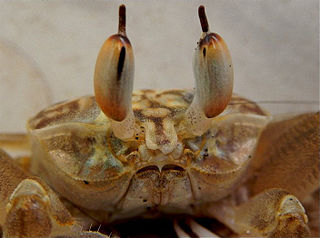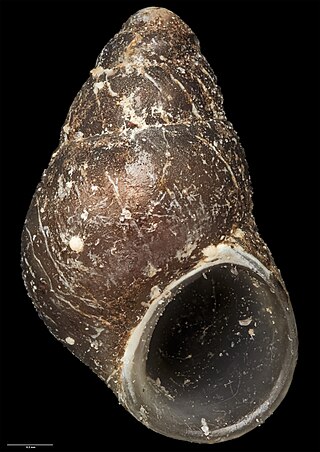
Ghost crabs are semiterrestrial crabs of the subfamily Ocypodinae. They are common shore crabs in tropical and subtropical regions throughout the world, inhabiting deep burrows in the intertidal zone. They are generalist scavengers and predators of small animals. The name "ghost crab" derives from their nocturnality and their generally pale coloration. They are also sometimes called sand crabs, though the name refers to various other crabs that do not belong to the subfamily.

Ocypode is a genus of ghost crabs found in the sandy shores of tropical and subtropical regions throughout the world. They have a box-like body, thick and elongated eyestalks, and one claw is larger than the other in both males and females. They inhabit deep burrows in the intertidal zone. They are primarily nocturnal, and are generalist scavengers and predators of small animals. The genus contains 21 species.

The Ocypodidae are a family of semiterrestrial crabs that includes the ghost crabs and fiddler crabs. They are found on tropical and temperate shorelines around the world.

Archaeotherium is an extinct genus of entelodont artiodactyl endemic to North America during the Eocene and Oligocene epochs. Archaeotherium fossils are most common in the White River Formation of the Great Plains, but they have also been found in the John Day Basin of Oregon and the Trans-Pecos area of Texas. Archaeotherium's fossils come from North America, between the Priabonian and Rupelian stages of the Eocene and Oligocene. Up to fifteen species of Archaeotherium have been identified, which are divided into three subgenera. One contains the type species, A. mortoni, among others; another contains very large taxa formerly named Megachoerus and Pelonax; and the last contains A. calkinsi.

Ptychodus is a genus of extinct large durophagous (shell-crushing) lamniform sharks from the Cretaceous period, spanning from the Albian to the Campanian. Fossils of Ptychodus teeth are found in many Late Cretaceous marine sediments worldwide.

The Atlantic ghost crab, Ocypode quadrata, is a species of ghost crab. It is a common species along the Atlantic coast of the United States, where it is the only species of ghost crab; its range of distribution extends from its northernmost reach on beaches in Westport, Massachusetts, south along the coasts of the tropical Western Atlantic Ocean to the beach of Barra do Chui, in Rio Grande do Sul in southern Brazil.

Ocypode ceratophthalmus, the horned ghost crab or horn-eyed ghost crab, is a species of ghost crab. It lives in the Indo-Pacific region ; from the coast of East Africa to the Philippines and from Japan to the Great Barrier Reef. They also occur in the Pacific Islands to as far east as Polynesia and Clipperton Island. As their common name implies, O. ceratophthalmus possess eyestalks extending beyond the eyes into long points, which are longer in adults, and shorter in juveniles. The crabs have a box-shaped body, 6–8 centimetres (2.4–3.1 in) across the carapace, with a darker markings towards the rear in the shape of an H. The outer edges of the eye-sheaths are also sharp and broadly triangular and distinctly pointing sideways in larger individuals. O. ceratophthalmus can run at speeds of up to 2.1 metres per second (6.9 ft/s).

Ocypode ryderi, also known as the pink ghost crab, is a species of ghost crab found on the east coast of Africa from the Eastern Cape Region to Kenya.

Ocypode gaudichaudii, also known as the painted ghost crab or cart driver crab, is a species of crab found on Pacific beaches from El Salvador to Chile as well as on the Galápagos Islands. The species was first described by Henri Milne-Edwards and Hippolyte Lucas in 1843.

The gulf ghost crab, Hoplocypode occidentalis, is a species of ghost crabs native to the Pacific coast of the Americas, from the Gulf of California to Colombia. It is the only species in the genus Hoplocypode. Gulf ghost crabs are medium-sized, reaching a maximum overall body diameter of 6 in (15 cm). They are one of only two ghost crab species found in the eastern Pacific. However, gulf ghost crabs can easily be distinguished from painted ghost crabs by the absence of "horns" on their eyes.

Ocypode africana, commonly known as the African ghost crab, is a species of ghost crabs native to the eastern Atlantic coast of western Africa, from Mauritania to Namibia. They are medium-sized ghost crabs reaching carapace width of 3.4 cm (1.3 in). They can vary in coloration from pinkish to dark grey. They are one of only two ghost crab species found in the eastern Atlantic. However, African ghost crabs can easily be distinguished from tufted ghost crabs by the absence of long tufts of hair on the tip of their eyestalks.

Ocypode brevicornis is a species of ghost crab native to the Indian Ocean, from the Gulf of Oman to the Nicobar Islands. They are relatively large ghost crabs with a somewhat trapezoidal body. The carapace reaches a length of 41 mm (1.6 in) and a width of 50 mm (2.0 in). They are a mottled brown to yellow in coloration. Like other ghost crabs, one of their claws is much larger than the other. Their eyestalks are large and elongated, tipped with prolongations at the tip known as styles. They are common inhabitants of open sandy beaches, living in burrows in the intertidal zone.

Ocypode convexa, commonly known as the golden ghost crab, or alternatively the western ghost crab or yellow ghost crab, is a species of ghost crabs endemic to the coast of Western Australia, from Broome to Perth. They are relatively large ghost crabs, with a carapace growing up to 45 mm (1.8 in) long and 52 mm (2.0 in) wide. They are easily recognisable by their golden yellow colouration. Like other ghost crabs they have box-like bodies with unequally sized claws. They also have large eyestalks with the cornea occupying most of the bottom part.

Eatoniella mortoni is a species of marine gastropod mollusc in the family Eatoniellidae. First described by Winston Ponder in 1965, it is endemic to the waters of New Zealand. The species has been used to study the effects of ocean acidification, as it is known to thrive in carbon dioxide-rich environments.

Ocypode macrocera, the red ghost crab, is a species of crab in the family Ocypodidae. It is a medium-sized species of Ocypode found in Pakistan, India, Sri Lanka, and Myanmar. In adult males, the outer edges of the eye orbits are tooth-shaped and project forward. The palm of the claws are densely covered with tubercles on the upper surface, with distinctively serrated upper and lower margins. The stridulating ridge has 35 to 56 tubercles with striae. The tip of the smaller claw is characteristically blunt. Their eyestalks possess styles.

Ocypode jousseaumei is a small to medium-sized species of Ocypode found only in the Gulf of Aden and the Gulf of Oman. They are very similar to O. fabricii, but they are not found in the same localities.
Ocypode nobilii is a small-sized species of Ocypode found in the Gulf of Thailand, and the Malaysian Peninsula to northern Borneo. They are very similar to O. stimpsoni but they do not share the same distribution range.

Ocypode rotundata, also known as the rounded ghost crab, is a large-sized species of Ocypode found in the southern coast of the Arabian Peninsula to northern India, including the Persian Gulf. They are very similar to O. saratan but can be distinguished by having 10 to 15 irregularly spaced elongated tubercles with striae on their stridulating ridges and a thumb-like palp on their gonopods. Their eyestalks possess styles.
Ocypode saratan, also known as the Red Sea ghost crab, is a medium to large-sized species of Ocypode found in the Red Sea. Very common species in the Red Sea, and one of only two species known from there. Also known from Madagascar through Indian Ocean to the Western Pacific. Their eyestalks possess styles.
Ocypode stimpsoni is a small-sized species of Ocypode found in China, the Korean Peninsula, and Japan. They closely resemble O. mortoni but can easily be distinguished because they lack styles on their eyestalks.















